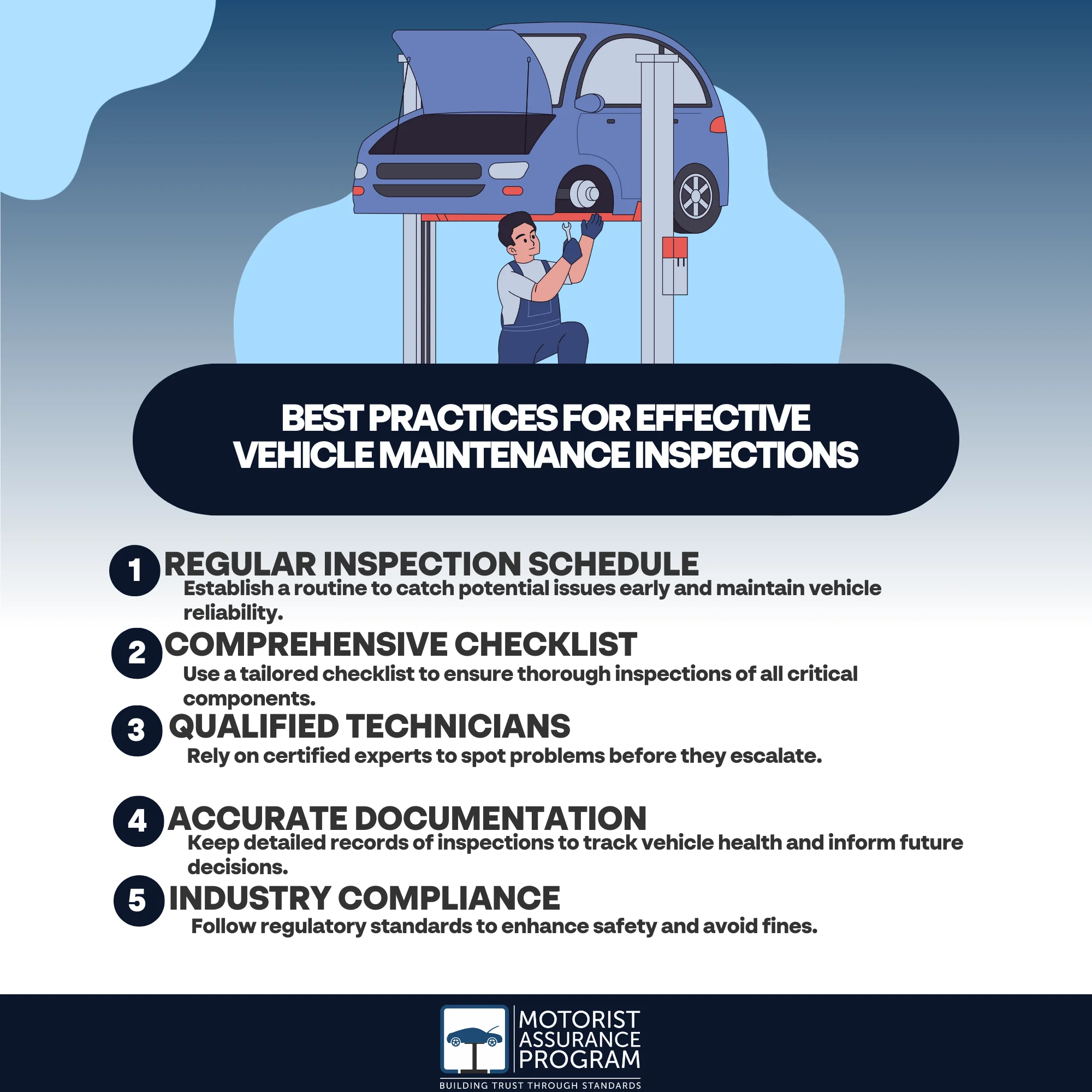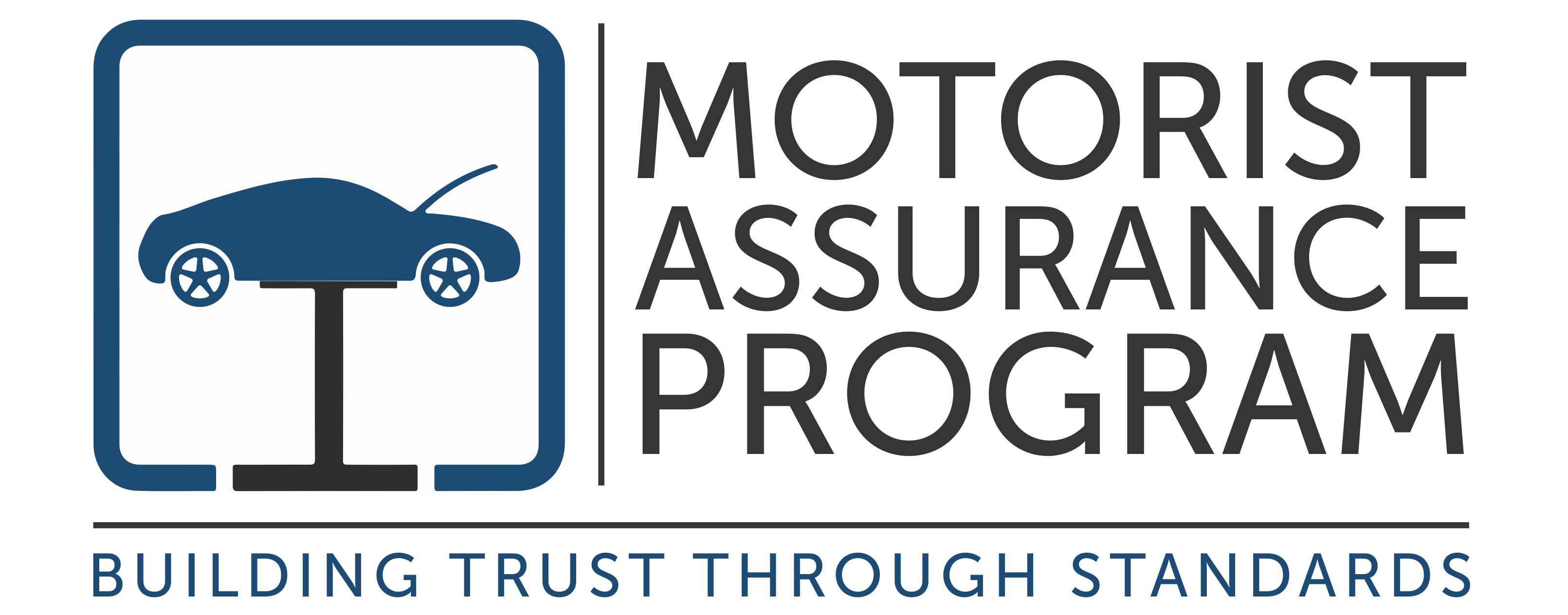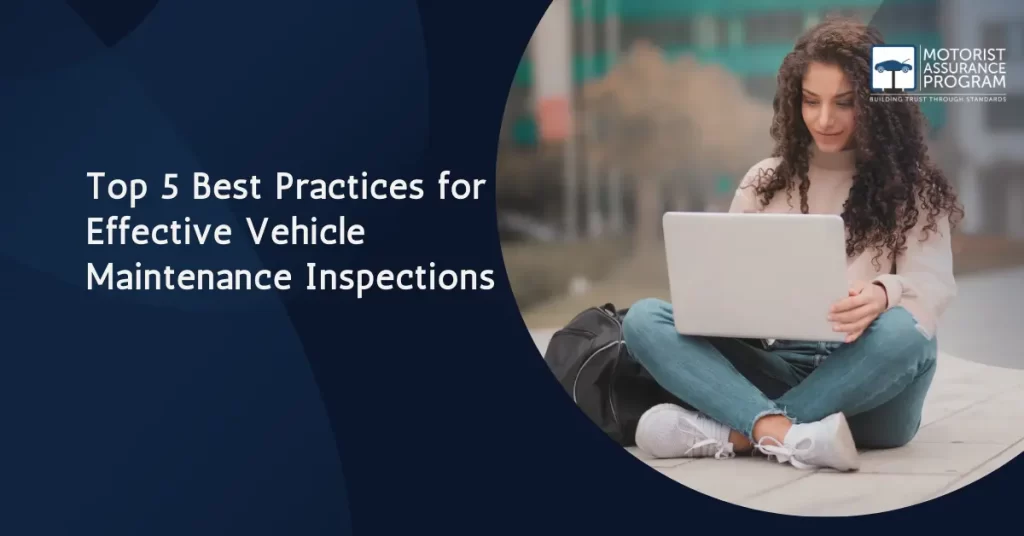To guarantee your vehicle remains in top shape, follow these five best practices for maintenance inspections. First, establish a regular inspection schedule to catch potential issues early. Second, utilize an extensive checklist tailored to your vehicle’s needs, covering essential areas like fluid levels and brakes. Third, rely on qualified personnel—certified technicians have the expertise to identify problems. Fourth, keep accurate documentation of inspections; this helps track your vehicle’s condition and informs future decisions. Finally, comply with industry standards to uphold safety protocols. By implementing these practices, you’ll boost your car’s longevity and reliability in no time. Want to explore more tips?

Key Takeaways
-
Establish a regular inspection schedule to address seasonal challenges and maintain vehicle reliability and value.
-
Utilize a comprehensive checklist tailored to the vehicle type, ensuring all key areas are inspected thoroughly.
-
Involve qualified personnel for expert inspections, as their training helps identify potential issues early.
-
Maintain accurate documentation of inspections to track vehicle condition and inform future maintenance decisions.
-
Ensure compliance with industry standards during inspections to enhance safety and avoid regulatory fines.
Regular Inspection Schedule
To keep your vehicle running smoothly, establishing a regular inspection schedule is crucial. This proactive approach not only guarantees your car remains in top shape but also helps you catch potential issues before they escalate.
By committing to regular inspections, you can implement seasonal adjustments tailored to the changing weather conditions, which can greatly impact your vehicle’s performance. Understanding the importance of fuel economy information can also guide you in making informed decisions about vehicle maintenance.
During different seasons, your car faces unique challenges. For instance, winter can bring icy roads and battery issues, while summer heat can strain your cooling system. By scheduling inspections at the start of each season, you can address these specific needs.
Incorporating preventative measures during these inspections can save you time and money down the line. Simple checks—like tire pressure, fluid levels, and brake functionality—can make a world of difference.
Plus, staying on top of maintenance helps maintain your vehicle’s value, keeping it reliable for years to come.
You don’t have to be a car expert to follow a regular inspection schedule. Just a little planning can go a long way, empowering you to take control of your vehicle’s health, guaranteeing safer and smoother journeys.
Comprehensive Checklist Utilization
A comprehensive checklist can be a game changer when it comes to vehicle maintenance inspections. By using an all-encompassing checklist, you can guarantee that no detail gets overlooked during your inspections.
It’s crucial to customize your checklist to fit the specific needs of your vehicle and its unique features, especially if you own an electric or hybrid vehicle. This way, you can address potential issues before they escalate into more significant problems.
You should also consider your inspection frequency. Regular inspections help catch minor issues early on, preventing costly repairs down the line. Whether you inspect your vehicle monthly or quarterly, a well-structured checklist will guide you through each step, making the process efficient and effective.
Remember to include key areas such as fluid levels, tire pressure, brake systems, and lights. By focusing on these critical components, you’re not just following a routine; you’re actively safeguarding your vehicle’s performance and longevity.
Don’t underestimate the power of a good checklist—it’s more than just a list; it’s your partner in maintaining a safe and reliable vehicle. Embrace this tool, and you’ll drive with greater confidence, knowing your vehicle is in top shape.
Qualified Personnel Involvement
Qualified personnel play an essential role in vehicle maintenance inspections, guaranteeing that every aspect of your vehicle receives the expert attention it deserves. When you rely on certified technicians, you’re not just getting a quick check-up; you’re investing in the safety and longevity of your vehicle.
These professionals undergo rigorous training programs that equip them with the skills necessary to identify potential issues before they escalate into costly repairs. Certification requirements vary by region, but they typically include a combination of education and hands-on experience.
This guarantees that these technicians are well-versed in the latest maintenance practices and technologies. When you choose to have your vehicle inspected by qualified personnel, you can trust that they’re knowledgeable about specific makes and models, allowing them to provide tailored care.
Documentation and Reporting
While you may focus on the immediate aspects of vehicle maintenance, documentation and reporting are crucial for guaranteeing thorough inspections. Keeping accurate records of your inspections helps you track the vehicle’s condition over time, making it easier to identify recurring issues.
By utilizing inspection software, you can streamline this process, capturing data quickly and efficiently. Digital records not only save physical space but also make it easier to share important information with your team.
When everyone has access to the same data, it improves communication and helps guarantee that nothing falls through the cracks. Moreover, maintaining up-to-date documentation allows you to stay on top of any necessary repairs and services, ultimately prolonging the life of your vehicle.
You’ll find that regularly reviewing these records can highlight patterns and trends that inform future maintenance decisions, making your inspections more effective.
Compliance With Industry Standards
Meeting industry standards is vital for guaranteeing that your vehicle maintenance inspections aren’t only effective but also compliant with regulations. By adhering to regulatory requirements, you can help safeguard your vehicle’s performance and longevity.
It’s important to stay updated on these guidelines, as they often evolve to meet the latest safety protocols. When you conduct inspections, make certain you’re aware of what’s mandated in your area. This includes checking key components like brakes, tires, and lights, which directly affect safety.
Following these protocols not only helps you avoid potential fines but also promotes a culture of safety within your organization. Also consider implementing a regular training program for your staff to make sure everyone understands compliance standards.
Frequently Asked Questions
How Much Does a Vehicle Maintenance Inspection Typically Cost?
A vehicle maintenance inspection typically costs between $50 and $150, depending on your location and the service provider. When budgeting, consider this inspection cost as part of your regular vehicle upkeep expenses.
Can I Perform Inspections on My Own Vehicle?
Yes, you can perform inspections on your own vehicle. Use self inspection tips like checking fluid levels and tire pressure. Regular DIY maintenance helps keep your car in great shape and saves you money in the long run.
What Tools Are Necessary for a Vehicle Maintenance Inspection?
For a thorough vehicle maintenance inspection, you’ll need an inspection checklist and essential equipment like a tire pressure gauge, flashlight, wrenches, and a socket set. These tools help you assess your vehicle’s condition effectively.
How Long Does a Typical Vehicle Inspection Take?
A typical vehicle inspection takes about 30 to 60 minutes, depending on the inspection procedures involved. You’ll find that thorough inspections guarantee safety and reliability, making the duration worth the time invested in your vehicle’s upkeep.
What Are the Consequences of Skipping Regular Inspections?
Skipping regular inspections can lead to serious safety risks, such as mechanical failures or accidents. You might also face higher repair costs down the line, as small issues can escalate into major problems if ignored.
Conclusion
By prioritizing regular inspections and following these best practices, you’re not just maintaining your vehicle; you’re investing in your safety and peace of mind. So, take charge of your vehicle’s health and guarantee it’s road-ready. Remember, a little effort today can prevent a lot of trouble tomorrow—stay proactive and drive with confidence!


